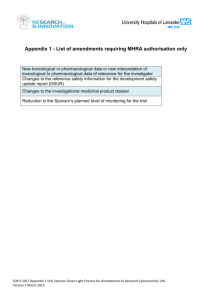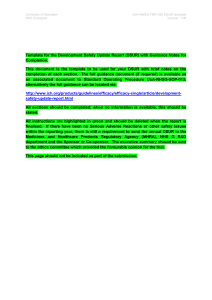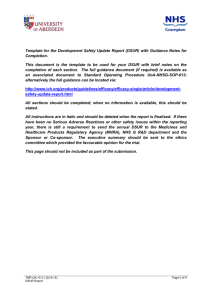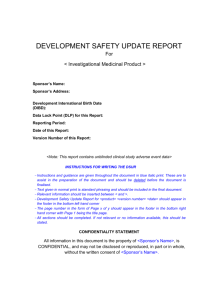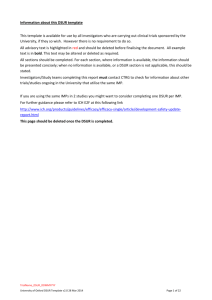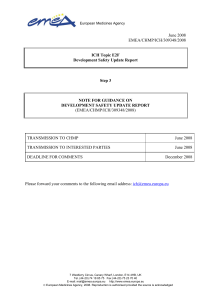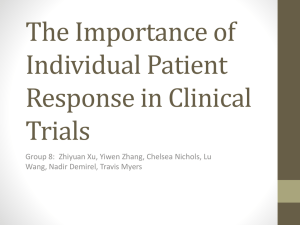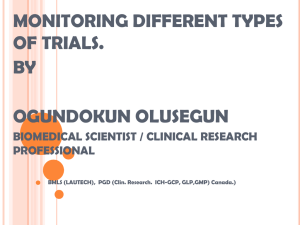Template for the Development Safety Update Report (DSUR) with
advertisement
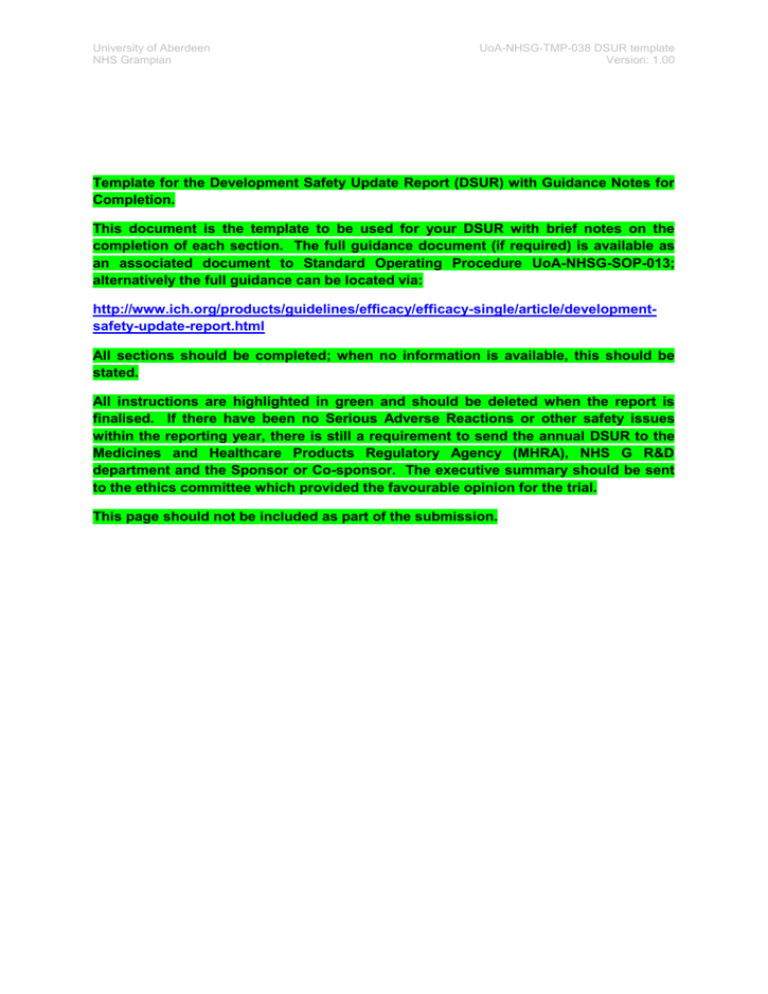
University of Aberdeen NHS Grampian UoA-NHSG-TMP-038 DSUR template Version: 1.00 Template for the Development Safety Update Report (DSUR) with Guidance Notes for Completion. This document is the template to be used for your DSUR with brief notes on the completion of each section. The full guidance document (if required) is available as an associated document to Standard Operating Procedure UoA-NHSG-SOP-013; alternatively the full guidance can be located via: http://www.ich.org/products/guidelines/efficacy/efficacy-single/article/developmentsafety-update-report.html All sections should be completed; when no information is available, this should be stated. All instructions are highlighted in green and should be deleted when the report is finalised. If there have been no Serious Adverse Reactions or other safety issues within the reporting year, there is still a requirement to send the annual DSUR to the Medicines and Healthcare Products Regulatory Agency (MHRA), NHS G R&D department and the Sponsor or Co-sponsor. The executive summary should be sent to the ethics committee which provided the favourable opinion for the trial. This page should not be included as part of the submission. University of Aberdeen NHS Grampian UoA-NHSG-TMP-xxx DSUR template Version:1.0 ICH E2F DSUR – Non-Commercial Sponsor Insert Study Title Insert Study Acronym DSUR number Reports should be numbered sequentially Investigational drug(s) Reporting period dd/mm/yyyy – dd/mm/yyyy Date of the Report dd/mm/yyyy Sponsor(s) name(s) and address(es) Applicable eudraCT numbers eudraCT numbers of all trials reported Chief Investigator responsible for DSUR submission: Name: Signature: The cautionary statement below should be amended as appropriate Note: This Development Safety Update Report contains confidential information. This report includes unblinded adverse event data. Page 1 of 9 University of Aberdeen NHS Grampian UoA-NHSG-TMP-xxx DSUR template Version:1.0 Executive Summary This section should provide a concise summary of the important information contained in the report. Together with the title page, it can serve as a ‘stand-alone’ document suitable for the submission to ethics committees and other stakeholders. The following information should be included in the Executive Summary: Introduction – report number and reporting period; Investigational drug(s) – mode(s) of action, therapeutic class (es), indication(s), dose(s), route(s) of administration, formulation(s); Estimated cumulative exposure of clinical trial subjects; Marketing approval(s)? (yes/no) – If yes, number of countries; Summary of overall safety assessment (based on section 18 of the DSUR); Summary of important risks (based on Section 19 of the DUSR); Actions taken for safety reasons including significant changes to the IB; Conclusions. Table of Contents 1. Introduction This section should include: Date of Clinical Trial Authorisation approval, Development International Birth Date of drug or International Birth Date of Drug as appropriate; Reporting period and sequential number of the report; Investigational drug(s) – mode(s) of action, therapeutic class (es), indication(s), dose(s), route(s) of administration, formulation(s); A brief description of the indication(s) and population(s) being studied. A short summary of the scope of the clinical trials covered by the report (e.g. all trials with the investigational drug, indication-specific trials, trials with combination products); A brief description and explanation of any information that has not been included in the DSUR (e.g. when written agreements with a partner company do not provide for exchange of all safety data); The rationale for submission of multiple DSURs for the investigational drug, if applicable. 2. Worldwide Marketing Authorisation Status Page 2 of 9 University of Aberdeen NHS Grampian UoA-NHSG-TMP-xxx DSUR template Version:1.0 This section should provide a brief narrative overview including: date of first approval, indication(s), approved dose(s), and where approved, if applicable. 3. Actions Taken in the Reporting Period for Safety Reasons This section should include a description of significant actions related to safety that have been taken during the reporting period by the sponsor, regulators, data monitoring committee or ethics committee that had an impact on the conduct of a specific clinical trial(s) or on the overall clinical development programme. The reason(s) for each action should be provided if known. Relevant updates to previous actions should also be summarised in this section (e.g. resumption of a clinical trial after suspension). This section should also summarise requests from regulatory authority(ies) that place a specific limitation on current or future development (e.g. a request to conduct long term animal studies before initiating a long term clinical trial, specification of a maximum dose to be evaluated, a request for specific safety data before initiating trials in paediatric subjects.) A cumulative listing of such requests from regulatory authorities should be provided, including any updates if applicable. This can be provided as a table, in an appendix, or in this section. 4. Changes to Reference Safety Information This section should list any significant safety-related changes to the Information Brochure (IB) or other reference safety information within the reporting period. Such changes might include information relating to exclusion criteria, contraindications, warnings, precautions, serious adverse drug reactions, adverse events of special interest, interactions, any important findings from non-clinical studies (e.g. carcinogenicity studies). Specific information relevant to these changes should be provided in the appropriate sections of the DSUR. 5. Inventory of Clinical Trials Ongoing and Completed during the Reporting Period This section should provide a brief overview of the clinical trials ongoing and completed by the sponsor during the reporting period, with detailed information presented in a table as an appendix (see examples in Appendix A, Tables 1 and 2). 6. Estimated Cumulative Exposure 6.1. Cumulative Subject Exposure in the Development Programme 6.2. Patient Exposure from Marketing Experience Sections 6.1 and 6.2 of the DSUR should provide information on cumulative exposure in clinical trials and the marketed setting, respectively. An estimation of cumulative subject exposure can help provide context for the cumulative summary tabulations of serious adverse events, and the overall assessment of safety. The accuracy of the estimation of clinical trial exposure might be limited because of a number of factors, including the rapidity of subject enrolment and the number of ongoing trials where treatment assignment remains blinded. Page 3 of 9 University of Aberdeen NHS Grampian UoA-NHSG-TMP-xxx DSUR template Version:1.0 For marketed drugs that are under clinical investigation, it might not be feasible or useful to obtain precise cumulative clinical trial exposure data, e.g. when the drug has been marketed for a number of years and/or has many indications. In these circumstances an explanation should be provided. 7. Data in Line Listings and Summary Tabulations Sections 7.1 – 7.3 of the DSUR should present important clinical safety information through: Interval line listings of the Serious Adverse Reactions that were reported during the period covered by the DSUR; and If appropriate, cumulative summary tabulations of serious adverse events that have been reported since the Developmental International Birth Date of the drug. The line listings and tabulations should include blinded and unblended clinical trial data. Unblinded data might originate from completed trials and individual cases that have been unblended for safety reasons (e.g. expedited reporting), if applicable. Data should not be unblinded for the specific purpose of preparing the DSUR. 7.1. Reference Information This section should specify the version of the medical coding dictionary used. If applicable, it should also specify the document and version used as Reference Safety Information for determining expectedness (e.g. IB, Summary of Product Characteristics). 7.2. Line Listings of Serious Adverse Reactions during the Reporting Period This section should summarise how case reports were selected for inclusion in the line listings. This section should not serve to provide analyses or conclusions based on the SARs. The line listings should be provided in an appendix (see Appendix A, Table 3). Where possible the line listings should include each subject only once regardless of how many SAR items are reported for the case. If there is more than one reaction, they should all be mentioned by the case should be listed under the most serious or primary adverse reaction. It is possible that the same subject could experience different SARs on different occasions (e.g. weeks apart). Under such circumstances, the SARs can be listed separately and a single subject can be included in the line listing more than once. 7.3. Cumulative Summary Tabulations of Serious Adverse Events See appendix A, Table 3 for an example of the headings for the line listing. 8. Significant Findings from Clinical Trials during the Reporting Period The information in this section can be provided by indication, when appropriate, and should address the following topics, when applicable: 8.1. Completed Clinical Trials Page 4 of 9 University of Aberdeen NHS Grampian UoA-NHSG-TMP-xxx DSUR template Version:1.0 Should provide a brief summary of clinically important emerging efficacy and safety findings from clinical trials completed during the reporting period. 8.2. Ongoing Clinical Trials Should provide details of clinically important safety information that has arisen from ongoing clinical trials (e.g. learned through interim safety analyses or as a result of unblinding of subjects with adverse events), this section should briefly summarise the issue(s). 8.3. Long-term Follow-up Where applicable, this section should provide information from long-term follow up of subjects from clinical trials of investigational drugs. 8.4. Other Therapeutic Use of Investigational Drug This section should include clinically important information from other programmes conducted by the same sponsor or co-sponsor that follows a specific protocol. 8.5. New Safety Data Related to Combination Therapies If this DSUR is for an investigational drug that is also under development as a component of a fixed combination product or a multi-drug regimen, this section should summarise important safety findings from the combination therapy DSUR. Conversely, if this DSUR is for a multi-therapy drug or fixed combination product, this section should summarise important safety information arising from trials on the individual components. 9. Safety Findings from Non-interventional Studies This section should summarise relevant safety information from sponsored or co-sponsored non-interventional studies that becomes available during the reporting period (e.g. observational studies, epidemiological studies, active surveillance programmes. 10. Other Clinical Trial/Study Safety Information This section should summarise relevant safety information from any other sponsored or cosponsored clinical trial/study sources that becomes available during the reporting period (e.g. results from pooled analyses or meta analyses of randomised clinical trials). 11. Safety Findings from Marketing Experience If the investigational drug has been approved for marketing in any country, this section should include a concise summary of key safety findings that have arisen from marketing experience and that became available to the sponsor during the reporting period. 12. Non-clinical Data This section should summarise major safety findings from non-clinical in vivo and in vitro studies (e.g. carcinogenicity, reproduction or immunotoxicity studies) ongoing or completed Page 5 of 9 University of Aberdeen NHS Grampian UoA-NHSG-TMP-xxx DSUR template Version:1.0 during the reporting period. Implications of these findings should be discussed in the Overall Safety Assessment (section 18) 13. Literature This section should summarise new and significant findings, either published in the scientific literature or available as unpublished manuscripts, relevant to the investigational drug during the reporting period. This section should include information from non-clinical and clinical studies and, if relevant an applicable, information on drugs of the same class. It should also summarise significant new safety information presented at a scientific meeting and published as an abstract; a copy of the abstract should be provided, if possible. 14. Other DSURs One single DSUR should be prepared for all trials being undertaken on one investigational drug. However, if multiple DSURs are to be prepared for a single investigational drug (e.g. covering different indications, development programmes, or formulations), this section should summarise significant findings from other DSURs if not presented elsewhere in the report. 15. Lack of Efficacy Data indicating lack of efficacy, or lack of efficacy relative to established therapy(ies), for investigational drugs intended to treat serious or life-threatening illnesses (e.g. excess cardiovascular adverse events in a trial of a new anti-platelet drug for acute coronary syndromes) could reflect a significant risk to the clinical trial subjects and should be summarised in this section. 16. Region-Specific Information The information in this section can be used to comply with national or regional requirements and can be provided in appendices to the DSUR. Should a DSUR be required for a country other than Britain the Chief Investigator should determine the requirements for that country. Examples of what may be included are: Cumulative summary tabulation of serious adverse reactions; List of subjects who died during the reporting period List of subjects who dropped out of clinical trials in association with an adverse event during the reporting period, whether or not thought to be drug related. Any safety issues should be addressed in Section 18 of the DSUR as appropriate; Significant manufacturing changes. 17. Late-Breaking Information This section should summarise information on potentially important safety findings that arise after the data lock point but while the DSUR is in preparation. Examples include clinically significant new case reports, important follow-up data, clinically relevant toxicological findings and any action that the sponsor or co-sponsors, data monitoring committee, or a Page 6 of 9 University of Aberdeen NHS Grampian UoA-NHSG-TMP-xxx DSUR template Version:1.0 regulatory authority has taken for safety reasons. Section 18 should also take account of this new data as appropriate. 18. Overall Safety Assessment This section should be a concise, integrated evaluation of all new relevant clinical nonclinical and epidemiological information obtained during the reporting period relative to the previous knowledge of the investigational drug. This assessment should consider cumulative experiences, new information collected in the period covered by the DSUR and, for investigational drugs with a marketing approval, clinically significant post-marketing data. It should not summarise or repeat information presented in previous sections of the DSUR, but should provide an interpretation of the information and its implications for the clinical trial population and the development programme. If appropriate, separate assessments can be provided by therapeutic area, route of administration, formulation and/or indication. 19. Summary of Important Risks This section should provide a concise, cumulative, issue-by-issue list of important identified and potential risks, e.g. those that might lead to warning, precautions, or contraindications on labelling. Such risks might include, for example, toxicities known to be associated with a particular molecular structure or drug class, or concerns based on accumulating non-clinical or clinical data. Each risk should be re-evaluated annually and re-summarised as appropriate, based on the current state of the knowledge. New information should be highlighted. The appropriate level of detail is likely to be dependent on the stage of the drug development. For example, summaries covering drugs in early development might include information on individual cases, whereas in later development, as more knowledge and perspective are gained the information on each risk might be less detailed. Risks that have been fully addressed or resolved should remain in the summary and be briefly described, e.g. findings from toxicology studies or early clinical trials that were not borne out by later clinical data. 20. Conclusions This section should briefly describe any changes to the previous knowledge or efficacy and safety resulting from information gained since the last DSUR. The conclusions should outline the actions that have been or will be taken to address emerging safety issues. 21. Appendices to the DSUR The DSUR should be accompanied by the following appendices, as appropriate, numbered as follows: 1. 2. 3. 4. 5. 6. 7. Investigators Brochure; Cumulative Table of Important Regulatory Requests; Status of Ongoing and Completed Trials; Cumulative Summary Tabulations of Demographic Data; Line Listings of Serious Adverse Reactions; Cumulative Summary Tabulation of Serious Adverse Events; Scientific Abstracts (if relevant). Page 7 of 9 University of Aberdeen NHS Grampian UoA-NHSG-TMP-xxx DSUR template Version:1.0 Appendix A- Tables and Table headings for Clinical Trial Listings Table 1 – Overview of Ongoing Studies [Study Drug] Study Phase Country Study Study Dosing Study FVFP† Planned Subject ID Title design regimen Population enrolment exposure‡ †FVFP = first patient first visit ‡ Based upon total numbers of patients recruited as of [date] and applied randomisation schemes. Table 2 – Overview of Studies Completed During the DSUR period [Study drug] Study ID Phase Country Study Title Study design Dosing regimen Study Subject Population exposure per treatment arm (M/F) Table 3 – Examples of Headings for Interval Line Listings of Serious Adverse Reactions Study ID EudraCT number Case ID/Subject number† Country Gender Age Serious Adverse Drug Reactions (SARs) Outcome Date of onsent Time to onset‡ Suspect drug Daily dose Route Formulation Dates of treatment Treatment duration Comments † Study/Centre/patient ‡ ‘Primary’ SAR only Page 8 of 9
